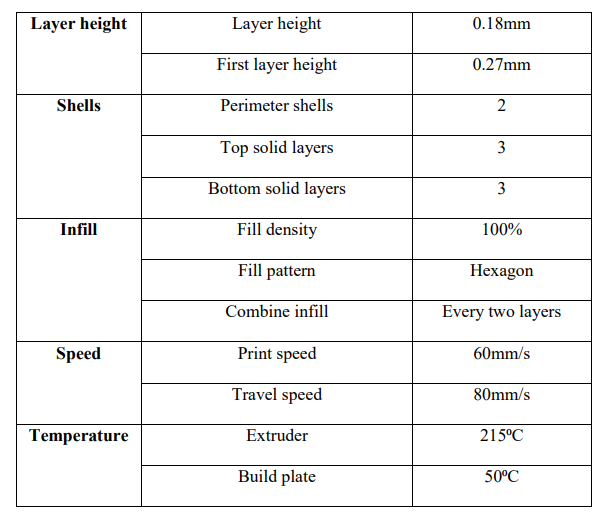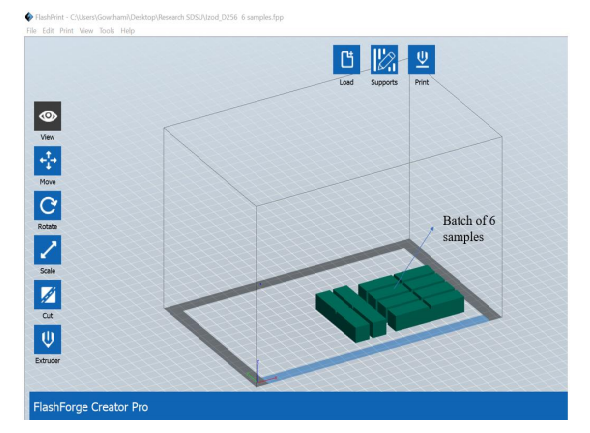In the recently published ‘A Study of the Effect of Heat Treatment on 3D Printed PLA Impact Strength,’ author Suresh Thota presents a thesis at South Dakota State University, centered around experimenting with materials and mechanical properties in 3D printing.
Because environment plays a large role in 3D printing and may have such a substantial effect on parts and prototypes, Thota investigates varying parameters like temperature and humidity, and how they affect PLA in terms of:
- Compressive strength
- Tensile strength
- Bending strength
- Impact strength
PLA is commonly used as a material for 3D printing, as it is made from renewable resources (corn and sugarcane) and is both biodegradable and biocompatible, making it useful in medical applications too. For this study, Thota and the research team used four spools of yellow PLA. They reported that this material was affordable and required low temperature nozzles to melt filament.
A Flash Forge Creator Pro was used to 3D print samples, with impact testing performed according to ASTM D256 test standards. Six pairs of PLA samples were heated to test the results of 100 percent humidity, placed in water within a range of 25⁰ C (±5⁰C) to 95⁰ C.
Temperatures were increased in 10⁰ C increments until reaching 95⁰C. After running eight different tests, the research showed that impact strength increased with higher temperature treatment, but also that samples exhibited the highest impact strength at higher temperatures—but only for short heat treatment.
For the humidity test, six samples were 3D printed for a total of 96 samples.
“Samples were impact tested immediately after two hours of heat heating in the water bath. Similarly, from the remaining samples, a different pair was tested after every two hours of heat treatment up to twelve hours,” stated the researchers. “The impact test of water heat treated (100% humidity) samples was conducted immediately by removing them from the water bath. The angle of the pendulum was recorded from the digital meter. The average angle of the two specimens was calculated after every test. The test results from the experiments were later analyzed by plotting graphs showing the time and the Impact strength for the different treatments.”
The low humidity test showed that PLA samples had ‘nearly similar impact strengths.’ Samples also displayed high impact strength above the glass transition temperature (60⁰C).
Heating and aging effects testing showed high impact strength in samples tested right after heat treatment, while samples impact tested after aging at room temperature resulted in ‘considerably’ lower impact strength—leaving Thota to conclude that the impact strength of PLA cannot be maintained at elevated levels with aging.
“The following recommendation for future research is made based on the results of this study:
Heat treating PLA specimens made with the addition of reinforcing fibers, micro or nanofillers, or selected additives.
The impact strength of PLA can be further studied by changing the printing parameters such as infill density and printing orientation.
Annealing the heat-treated samples in a water bath instead of room temperature air.”
Research regarding mechanical properties of 3D prints continues, and especially as users have a wide range of specific uses and preferences for what they are fabricating—leading them to consider issues such as influence of color, the use of 3D printing composites, and the effects of porosity.
What do you think of this news? Let us know your thoughts! Join the discussion of this and other 3D printing topics at 3DPrintBoard.com.
[Source / Images: ‘A Study of the Effect of Heat Treatment on 3D Printed PLA Impact Strength’]
Subscribe to Our Email Newsletter
Stay up-to-date on all the latest news from the 3D printing industry and receive information and offers from third party vendors.
You May Also Like
Air Force Awards Fortius Metals $1.25M to Qualify 3D Printing Wire for Hypersonic Applications
AFWERX, part of the US Air Force Research Laboratory (AFRL), awarded a Direct-to-Phase II Small Business Innovation Research (SBIR) contract worth $1.25 million to Colorado’s Fortius Metals, to accelerate qualification...
US Air Force Awards JuggerBot $4M for Large-format Hybrid 3D Printing
Large-format 3D printer manufacturer JuggerBot has received a $4 million grant to develop a large format 3D printer, courtesy of the Under Secretary of Defense, Research and Engineering Manufacturing Technology...
Where Have All AM’s Unicorns Gone?
In the rapidly evolving world of 3D printing, startups valued at over a billion dollars, known as unicorns, once seemed as fantastical as the mythical creatures themselves. While a few...
How My Childhood Fascination with Planes Led to Investing in 3D Printing
My fascination with aerospace started young, and I started studying planes–identifying them in the sky and learning everything I could about how they work. Fast forward to my first week...



































